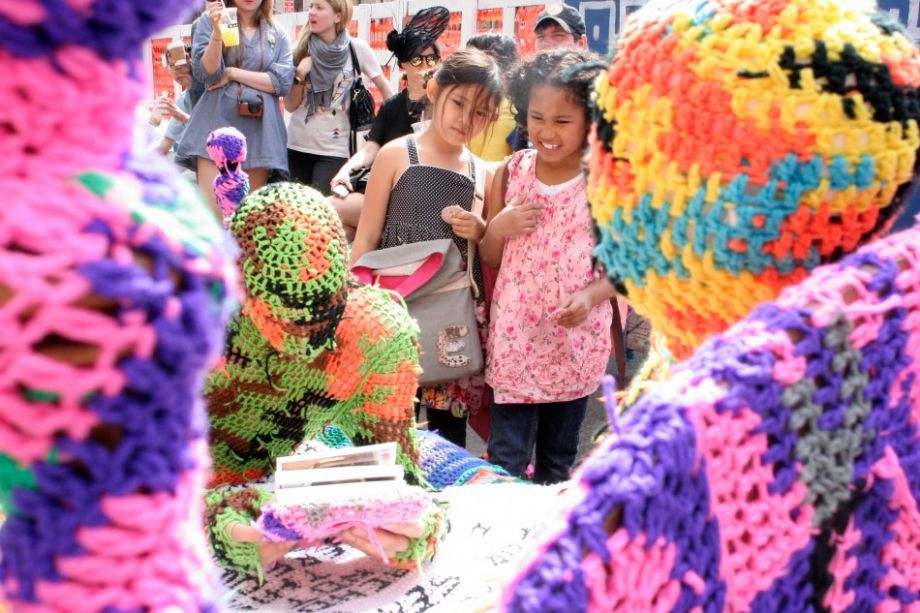If you want to have a good time, you go to the city. And if you want to unlock social and economic capital, the city — with its density of people, jobs and ideas — is good for that, too.
But what if you want to do both simultaneously? How you might pull that off was the topic of a Thursday panel discussion at the Ideas City, a New Museum-held conference now ongoing in New York. A four-day series of workshops, speeches and debates that culminates with a street festival in Manhattan on Saturday, the Ideas City confab is dedicated to seeking out untapped capital in the urban environment.
How this untapped capital can be found while having a little fun was up for discussion. The four-person panel, moderated by Kickstarter cofounder Yancey Strickler, explored a range of ways that “play” can benefit cities, strengthen social cohesion and even generate revenue.
The diversity of the panel was impressive, ranging from an artist-cum-community-organizer to an architect who helped design the High Line to a former senior policy analyst from the White House Office of Science and Technology. And their definitions of play and capital were equally varied. Artist Kemi Ilesanmi, for instance, detailed how the organization she runs is working to foster better communities by staging activities, such as yoga, at that most stagnation-prone urban environment: the Laundromat. The Laundromat Project provides a space, as Ilesanmi put it, “where strangers can become neighbors.”
Ilesanmi’s fairly literal interpretation of play, however, was balanced by more abstract perspectives from the other panelists whose backgrounds were more academic. Charles Renfro, of the architecture firm Diller Scofidio + Renfro, which co-designed New York’s High Line, talked about creating spaces where “what you’re anticipating is the un-anticipatable… We’re striving to make experiences that can be interpreted, used or co-opted by any number of people in any number of ways.”
Renfro recalled how the High Line, before it was turned into a park, was an abandoned place that New Yorkers snuck into; on any given night, you could find people playing up there. Playing, in this case, meant running around, drinking, smoking pot, taking pictures, making out — it was a respite from the rules of the city. “The idea of illicitness and play were things we brought into our design,” he said.
But just because the High Line is no longer lawless doesn’t mean that it’s not a space for creativity. Eric Zimmerman, cofounder of the Institute of Play, a non-profit that looks at the nexus of games and learning, emphasized that when you create a game, what you’re essentially creating is a set of rules. “Rules don’t sound fun,” Zimmerman said, but once you’re in that rule-bound space, you find creative ways to work within those rules. This is play, in its purest form.
You could look at amenities like the High Line as the physical manifestation of rule-bound play -— there are rolling chairs that can be rearranged and other flexible amenities that people can reconfigure. Renfro talked about the cabaret singer who, shortly after the first phase of the High Line was completed, began appearing on the fire escape of her adjacent apartment building with a microphone to serenade its crowds. He even pointed to the flashers at the Standard, the Andre Balazs hotel that looms above the elevated park, who delight and scandalize park-goers by appearing naked in the windows of their rooms.
But to some degree, these examples only served to highlight how some of the newer public spaces in New York and other cities strictly regulate the types of play that they allow. The High Line is a tightly controlled space; its vendors are carefully selected, and it is patrolled by security guards who enforce its many bylaws. Even the cabaret singer and the Standard’s flashers, who play not on the High Line itself, but in their own private spheres within spitting distance of it, seemed to emphasize how too many rules can go from facilitating play to stifling it. Striking the right balance is the key.
Zimmerman cited an excellent example. A few years ago, a game called Macon Money aimed to bring together residents of Macon, Ga., who were segregated by race and class. Residents were given one half of a bond certificate redeemable for a particular amount of money, ranging from $10 to $100, that could be spent at local businesses. The catch was this: To get the money, the resident had to find the fellow citizen of Macon who had in their possession the other half of the bond certificate. No clues of any kind were given, but the players could use any means necessary to find their missing half. The result? Many residents ended up meeting people in their city who they otherwise never would have.
This game allowed its players to unlock both social and economic capital in their city while having fun in the process. Other cities seeking similar results are trying to create the conditions for their residents to do the same.

Will Doig was formerly Next City’s international editor. He's worked as a columnist at Salon, an editor at The Daily Beast, a lecturer at the New School, and a communications staffer at the Open Society Foundations. He is the author of High-Speed Empire: Chinese Expansion and the Future of Southeast Asia, published by Columbia Global Reports.
















